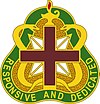United States Army Medical Command
| U.S. Army Medical Command | |
|---|---|

The MEDCOM shoulder sleeve insignia incorporates a modified caduceus with snakes entwining a winged sword, rather than the conventional staff.
|
|
| Active | 1993 - Present |
| Country | United States |
| Allegiance | United States |
| Branch | United States Army |
| Type | Medical Command |
| Garrison/HQ | Fort Sam Houston, San Antonio, Texas |
| Website | www |
| Commanders | |
| Current commander |
LTG Nadja West |
| Insignia | |
| Distinctive unit insignia |  |
The U.S. Army Medical Command (MEDCOM) is a direct reporting unit of the U.S. Army that provides command and control of the Army's fixed-facility medical, dental, and veterinary treatment facilities, providing preventive care, medical research and development and training institutions.
MEDCOM is commanded by the Army Surgeon General, currently Lt. Gen. Nadja West. The Surgeon General is also head of the U.S. Army Medical Department (the AMEDD).
MEDCOM is divided into Regional Health Commands (RHCs) that oversee day-to-day operations and exercise command and control over the Medical Treatment Facilities (MTFs) in their regions. There are currently four of these regional commands:
MEDCOM maintains day-to-day health care for soldiers, retired soldiers and the families of both. Despite the wide range of responsibilities involved in providing health care in traditional settings, as well as on the battlefield, quality of care compares very favorably with that of civilian health organizations, when measured by civilian standards, according to findings of the DoD's Civilian External Peer Review Program (CEPRP). Many Army medical facilities report on their own quality-of-care standards on their individual website.
When Army field hospitals deploy, most clinical professional and support personnel come from MEDCOM's fixed facilities. In addition to support of combat operations, deployments can be for humanitarian assistance, peacekeeping, and other stability and support operations. Under the Professional Officer Filler System (PROFIS), up to 26 percent of MEDCOM physicians and 43 percent of MEDCOM nurses are sent to field units during a full deployment. To replace PROFIS losses, Reserve units and Individual Mobilization Augmentees (non-unit reservists) are mobilized to work in medical treatment facilities. The department also provides trained medical specialists to the Army's combat medical units, which are assigned directly to combatant commanders.
...
Wikipedia
